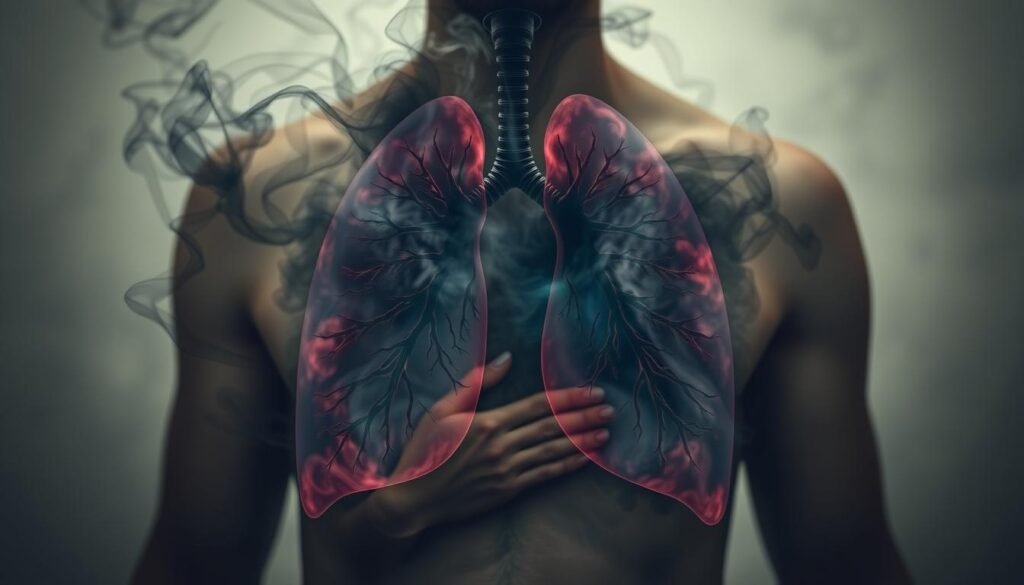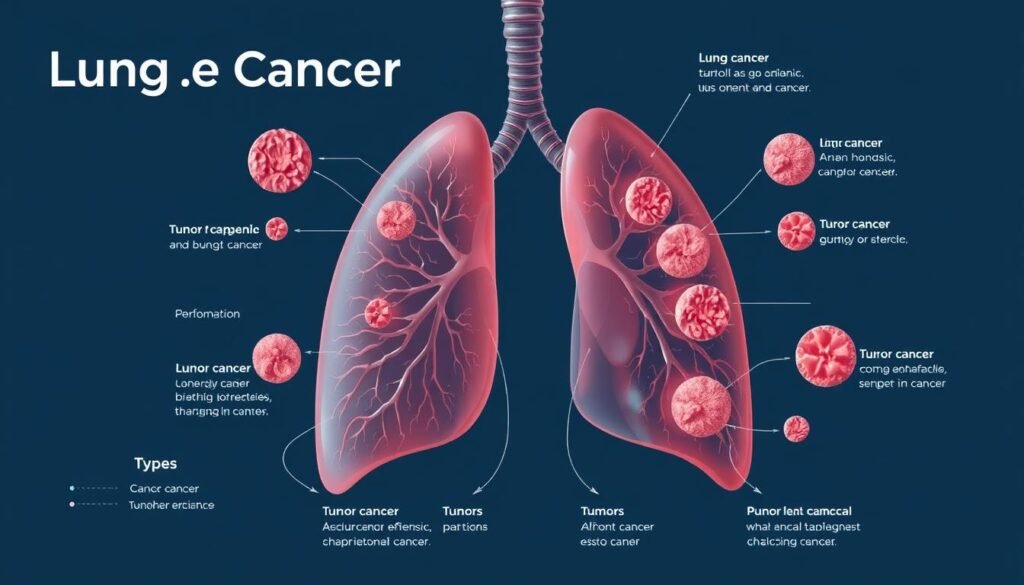Lung cancer causes nearly 25% of all cancer deaths in the U.S. This fact shows how important it is to know the common symptoms of lung cancer. Often, lung cancer is not found until it’s very advanced. Finding lung cancer early can make a big difference in treatment and how well patients do.
Here, you’ll learn about key symptoms of lung cancer. These include lasting coughs and chest pains. Seeing a doctor if you have these symptoms is critical. Being alert and informed helps you take care of your health better.
Key Takeaways
- Lung cancer can often go unnoticed until advanced stages.
- Persistent coughs are a common symptom to watch for.
- Coughing up blood is a significant warning sign of lung cancer.
- Chest pain or difficulty breathing are also symptoms to be aware of.
- Early detection significantly improves treatment outcomes.
- Consultation with a healthcare provider is crucial for an accurate diagnosis.
- Staying informed about lung cancer symptoms can lead to early intervention.
Understanding Lung Cancer Symptoms
Lung cancer is a major health issue. It’s caused by the growth of strange cells in the lungs. This can happen because of smoking or being around toxic stuff in the environment. Knowing about lung cancer means understanding its two main types. These are non-small cell lung cancer (NSCLC) and small cell lung cancer (SCLC). Each has different symptoms and ways to treat them.
What is Lung Cancer?
Lung cancer is a serious condition that can show up in various ways. The most common type, non-small cell lung cancer, is about 85% of all cases. This group includes adenocarcinoma, squamous cell carcinoma, and large cell carcinoma. SCLC is mostly caused by smoking. It grows fast and can lead to severe symptoms like bone pain and confusion. Sometimes, lung cancer doesn’t show symptoms at first. This makes early detection hard.
Importance of Early Detection
Finding lung cancer early is key. People who are 40 and older should think about getting a chest x-ray if they have two or more weird symptoms. These can include a constant cough, losing weight without trying, and chest pain. Catching lung cancer early greatly improves the chance of beating it. Watching for symptoms and getting checked out quickly is crucial.
Patients should use symptom trackers and talk to doctors if they’re worried. For more info on these symptoms, check out this detailed guide here.
Common Symptoms of Lung Cancer to Watch For
It’s key to catch lung cancer signs early. Many symptoms can hint at this health issue. Knowing them helps with fast medical advice and possibly finding it early.
Persistent Cough
A cough that doesn’t go away is a big red flag for lung cancer. It’s serious if it gets worse with time. People often think it’s just allergies or a cold, but it shouldn’t be ignored. If your cough sticks around, see a doctor for it could signal lung cancer.
Chest Pain
Chest pain with lung cancer hurts more when you breathe deeply, cough, or laugh. It can feel sharp or dull and really affect your day. Since it might mean different health issues, get checked if chest pain doesn’t stop.
Coughing Up Blood
Seeing blood when you cough is a red alert. This frightening sign means it’s time for a doctor’s visit. Spotting it early is key to figuring out the next steps.
| Symptom | Description | Importance |
|---|---|---|
| Persistent Cough | A long-lasting cough that worsens over time. | Indicates need for evaluation as a potential lung cancer symptom. |
| Chest Pain | Discomfort in the chest that intensifies with certain activities. | Could suggest lung cancer or other serious conditions. |
| Coughing Up Blood | Hemoptysis or rust-colored sputum. | Major warning sign that demands immediate attention. |
Additional Symptoms to Be Aware Of
It’s crucial to know the symptoms of lung cancer early. Besides well-known signs, others like unexplained weight loss, fatigue, hoarseness, and wheezing are key. These symptoms help in getting help from doctors early.
Unexplained Weight Loss
Unexplained weight loss is a major sign of lung cancer. Patients often lose weight without changing their diet. This can happen because the body needs more energy to fight cancer or because of less appetite. Both lead to significant weight changes.
Fatigue
Fatigue is a common symptom that doesn’t always come from daily work or stress. In those with lung cancer, it might be because of anemia or the body using more energy against the disease. Noticing ongoing tiredness is key to spotting health issues.
Hoarseness
Don’t ignore changes in your voice. Lung tumors can press on vocal cords or nearby areas, causing hoarseness. While it may be short-term or slight, it’s important to check out serious concerns with a doctor.
Wheezing
Wheezing makes a high-pitched sound when you breathe. It’s a sign that breathing paths might be blocked. If you hear this sound, see a doctor quickly. This is often related to lung health and breathing problems.
Recurring Lung Infections and Shortness of Breath
Recurring lung infections like bronchitis or pneumonia can be worrying. If they keep coming back despite treatment, it could mean something serious. For example, lung cancer might be the cause. Tumors can block airways, making it hard for your lungs to work right.
If you get infections over and over, it’s a sign you might need a doctor’s check-up. They will help find out what’s wrong.
Feeling short of breath is a key sign of lung cancer. It might feel hard to breathe or like your chest is tight. This is often because tumors or blockages reduce how much air your lungs can hold.
If you’re short of breath a lot, take it seriously. It could mean lung cancer or other conditions. A constant cough or other worrying symptoms mean you should see a doctor. For more info on lung cancer and screenings, visit this link.

| Symptom | Description | Associated Risks |
|---|---|---|
| Recurring Lung Infections | Frequent respiratory infections that do not resolve. | May indicate a blockage or tumor in the lung. |
| Shortness of Breath | Difficulty breathing or chest tightness. | Can arise from decreased lung capacity due to tumors. |
| Persistent Cough | A cough that continues for weeks without improvement. | Potential indicator of lung cancer or other serious conditions. |
Advanced Symptoms of Lung Cancer
As lung cancer gets worse, people might notice different serious symptoms. This shows the cancer has spread. It’s very important to spot these symptoms early for the right medical help. Here are a few key signs of late-stage lung cancer:
Bone Pain
When lung cancer reaches the bones, it causes bone pain. This pain mainly affects the back, hips, and pelvis, leading to ongoing discomfort. It can really affect everyday life and overall happiness.
Neurological Changes
If the cancer moves to the brain, it can cause neurological changes. Someone might have headaches, feel dizzy, or have weak limbs. These are serious signs of advanced cancer and mean you need medical help right away to handle these issues.
Fluid Retention and Jaundice
Fluid may build up, especially in the belly, and jaundice can happen. Jaundice makes the skin and eyes turn yellow. These signs show lung cancer might be affecting the liver. It’s very important to check these symptoms quickly with a doctor.
Knowing these late symptoms, like bone pain, changes in the brain, fluid buildup, and jaundice helps find and treat lung cancer faster. For detailed info, visit cancer.org.
| Advanced Symptom | Description | Significance |
|---|---|---|
| Bone Pain | Discomfort in areas such as the back, hips, and pelvis. | Indicates potential metastasis to the bones. |
| Neurological Changes | Symptoms like headaches, dizziness, or limb weakness. | Signals possible tumor spread to the brain. |
| Fluid Retention | Swelling in the abdominal area. | Can indicate serious liver involvement. |
| Jaundice | Yellowing of the skin and eyes. | Reflects liver damage or dysfunction. |
Specific Types of Lung Cancer and Their Symptoms
Knowing about lung cancer types is key to spotting symptoms and picking the right treatment. The main ones are non-small cell lung cancer (NSCLC) and small cell lung cancer (SCLC). Each has its own signs and traits.
Non-small cell lung cancer makes up about 80 percent of cases. It usually grows slowly. Signs include a lingering cough, pain in the chest, and being short of breath. NSCLC is divided into three subtypes:
- Adenocarcinoma: The most common type, mostly seen in the outer lung areas. It’s also common in non-smokers.
- Squamous cell carcinoma: Found mainly in the lung’s center, near a bronchus.
- Large cell carcinoma: This can grow and spread faster than other NSCLC types.
Small cell lung cancer is about 15 percent of lung cancer cases. It’s mostly caused by smoking. Symptoms for SCLC tend to worsen quickly and can include:
- Rapid weight loss
- Severe difficulty in breathing
- Constant coughing
There are also less common lung cancer types, like carcinoid tumors and mesothelioma. Knowing these helps in catching lung cancer early through specific symptoms.

| Type of Lung Cancer | Prevalence | Common Symptoms |
|---|---|---|
| Non-small cell lung cancer (NSCLC) | 80% | Persistent cough, chest pain, shortness of breath |
| Adenocarcinoma | Most common NSCLC | Cough, chest pain, weight loss |
| Squamous cell carcinoma | Central lung location | Persistent cough, hemoptysis |
| Large cell carcinoma | Rapid growth | Chest pain, coughing |
| Small cell lung cancer (SCLC) | 15% | Rapid weight loss, severe shortness of breath |
| Carcinoid tumors | Rare | Unusual, often asymptomatic until advanced |
Paraneoplastic Syndromes Associated with Lung Cancer
Paraneoplastic syndromes are conditions that arise due to the body’s reaction to cancer. They can lead to significant changes in how the body works. These syndromes often appear before someone knows they have lung cancer. Knowing about these syndromes helps identify lung cancer symptoms early. This leads to quicker diagnosis and treatment.
What Are Paraneoplastic Syndromes?
Paraneoplastic syndromes happen when a tumor releases hormones or other substances. This causes abnormal reactions in the body, affecting different organs. About 10% of people with cancer experience these syndromes. They can be mistaken for other health issues. The effects vary depending on which organs are involved.
Common Symptoms Related to Syndromes
The symptoms of paraneoplastic syndromes can vary and be confusing. They may include:
- Fatigue – A common issue, often impacting daily life.
- Dizziness – Caused by effects on the nervous system.
- Changes in skin color or texture – These changes can be surprising and may not seem related to lung cancer.
In people with small-cell lung cancer, around 60% might face Lambert-Eaton myasthenic syndrome. This condition weakens the muscles. Also, tumors can release substances causing hypercalcemia, leading to weakness and nausea.
Doctors use diagnostic tests like CT scans, MRIs, and PET scans to find these syndromes. Treatment might include medications to reduce inflammation, immunotherapy to regulate the immune system, and therapy to fight harmful antibodies.
Why Timely Consultation with a Healthcare Provider is Crucial
It’s tough to spot symptoms of lung cancer early. They look a lot like other breathing problems. People might cough a lot, lose weight without trying, or feel chest pain. These signs can point to many issues, like infections or COPD. This is why seeing a healthcare provider quickly is key. They can dig deeper and figure out what’s really going on.
How Symptoms May Overlap with Other Conditions
These symptoms can be confusing, making patients see their doctors often before getting the right diagnosis. This shows how vital early help from a doctor is. If lung cancer signs aren’t looked at closely, mistakes can happen. A good look at medical history and symptoms is crucial to tell lung cancer from other conditions.
Importance of Professional Diagnosis
Getting a professional diagnosis helps confirm if it’s lung cancer. Doctors might use X-rays or CT scans, and take samples for tests. Finding it early improves treatment chances and survival rates. Data shows that catching lung cancer early greatly boosts the odds of beating it. So, acting fast is critical.

Risk Factors for Lung Cancer
It’s important to know the risk factors for lung cancer to prevent it and catch it early. The main cause of lung cancer is smoking, which is very harmful. Knowing about other risk factors is vital to lower chances of getting this serious disease.
Smoking and Its Impact
About 80% to 90% of lung cancer deaths in the U.S. are linked to smoking. Smokers are 15 to 30 times more at risk of getting lung cancer than non-smokers. The danger from smoking impact grows when mixed with other risks like radon and secondhand smoke.
Radon gas inside homes can greatly raise lung cancer risk, especially for smokers. Even non-smokers can get lung cancer, making up 20% of lung cancer deaths. This shows that smoking isn’t the only risk factor.
Other Environmental Factors
Many environmental factors also make lung cancer more likely. These include:
- Being around secondhand smoke from cigarettes, pipes, and cigars.
- Being exposed to harmful substances at work like asbestos, arsenic, and silica.
- Radon gas exposure, the second top cause of lung cancer.
- Air pollution, causing about 5% of lung cancer deaths, hits city dwellers harder.
Knowing these risks helps people make better choices for their health and surroundings. For more on lung cancer types and traits, check this guide.
Conclusion
It’s important to know the common signs of lung cancer for early detection and effective treatment. Lung cancer is the third most common cancer and the leading cause of cancer deaths in the U.S. This shows why being careful about our health matters.
People who smoke or are around harmful chemicals need to watch their health closely. They should see a doctor quickly if they notice any symptoms.
Studies tell us that 80% to 85% of lung cancers are a type called non-small cell lung carcinoma (NSCLC). Finding it early can really help with treatment. How long people survive lung cancer depends a lot on when it’s found. That’s why catching it early is so crucial—it leads to better survival rates and more treatment choices.
Learning about the signs of lung cancer and being watchful can save lives. Knowing more leads to more people getting checked early, which is key to handling this illness. By knowing the risks and staying aware, people can take steps to fight lung cancer.